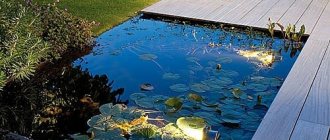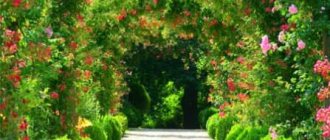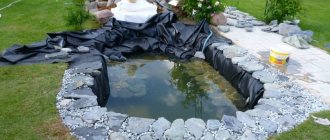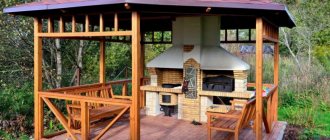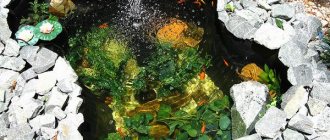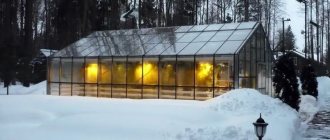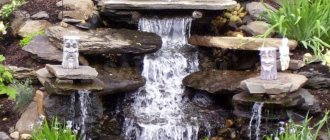What types of country ponds are there?
One of the most difficult decisions when creating your own decorative pond is the design. To decide on the future appearance of the reservoir, you need to clearly understand why you need it. Based on the main goals, several types can be distinguished:
Excavation and waterproofing works
You have chosen a place for the pond and determined what shape it will be. Now it's time to dig the pit. First, turning points and contours are marked with pegs. Then terraces are torn off, 30 cm deep and 20 cm wide. Several levels of terraces can be formed to place plants on them.
Now the main bowl is dug out. The slope of the banks should be approximately 45 °C. The walls of the bowl should taper downward to prevent soil from crumbling and reduce the load of water mass. The minimum depth of the reservoir should not exceed 60-80 cm: a shallow reservoir will freeze completely in winter and become very warm in summer, which will make it impossible to breed flora and fauna.
If waterproofing with film is planned, to secure it, a ditch about 15 cm deep is torn around the perimeter. After the foundation pit is ready, its bottom is leveled, all stones and roots that could damage the film are removed. The surface is covered with clean, washed sand to a depth of 5 cm, and a monolithic slab of M150 concrete is poured on top. After hardening, it is completely covered with geotextile fabric. All these measures will protect the waterproofing film from damage and extend its service life.
The next step will be waterproofing - laying butyl rubber or PVC maple. The size of the canvas is calculated from the total length of the pond and twice the depth. To secure the canvas along the edge, about half a meter of reserve is enough. The sheet is laid out freely, securing the edges with bricks along the edge. To eliminate the negative impact of groundwater, a reliable drainage system is created, which is also included in the waterproofing system.
All of the above waterproofing work is carried out before concreting, if this form of waterproofing device is chosen. When creating small ponds, concrete work is first carried out, and then the concrete surface is treated in several layers with a mixture of Hydroshield.
Pond as a decorative design element
It is a deep body of water. May include various lighting elements, a fountain, a decorative border or a mini-bridge. Unlike a small pond, it often serves as the center of a recreation area.
Located in close proximity to the veranda, benches, and picnic areas. Ideas for decorating a pond at your dacha can be seen in the photo.
Aquatic plants in design
There is a huge variety of aquatic plants. In order for the pond design to look attractive and function properly, the following types of aquatic plants must be present in it:
- Oxygenators are plants that produce oxygen. They carry out biological water purification and are food for fish (for example, koi carp). These include swamp turcha, hornwort, spicate urut, and water star.
- Floating plants serve to decorate the pond's surface. They can be placed in containers on underwater terraces. The most popular are duckweed, watercolor, azolla, and thick-petioled eichornia.
- For shallow ponds, deep-water plants are used in combination with floating ones. They are also planted in containers. The easiest to care for are water lily, egg capsule, and apongeton.
- Embankment plants are necessary to decorate the contours of the pond and to protect the water from overheating. Typically, low embankment plants are used for these purposes: fern, thuja, barberry, juniper, etc. Other plants planted in pots also look good.
Fish pond
Beautiful, bright fish will add variety to your life. Small aquariums have long been out of fashion. Nowadays, reservoirs that contain various living inhabitants are gaining popularity.
These can be decorative fish species. They will help you relax and are sure to attract children and pets. Or you can set up an artificial pond with fish or crayfish suitable for fishing and further consumption.
Deciding on the installation location
The pond needs to be installed in a place where you can admire it, and not hide it behind seven seals.
Accordingly, when creating such a masterpiece, it is worth considering several points: area, light, relief, presence of groundwater, soil composition, reflection, landscaping, visibility, power supply (if necessary), the ability to further expand your creation.
The list of work on the construction of an artificial pond should begin in the spring. This is necessary so that the latter can “take root.”
Swimming pond
Swimming pools in the country are also popular bodies of water. You can make a similar pond in your country house with your own hands. They serve not only as a decorative element, but also allow you to relax, cool off and swim.
This can be a very shallow and small pool; it is suitable for children. Or a full-fledged pond for adults. It all depends on the size of the plot and your capabilities. But remember that such a pond will require constant cleaning and special winter care. Also read about the compost bin.
Ponds with rocks at the bottom
Stones can be placed not only around the perimeter of the reservoir, but also under water. It will look especially attractive in clear water, so you will have to take care of regular cleaning of the pond. But your work will fully pay off with a beautiful landscape!
Choosing a pond location
How to make a pond? First of all, you need to decide on the place where it will be located. When choosing a territory, you need to decide whether you want a secluded pond or one visible from all sides.
If it is intended as a decorative element, then it is necessary to arrange it on a flat, open plane. If you plan to install a pool, then the best solution would be to place it behind the house or behind some bushes, trees, etc. Read here: vine fence.
When choosing an area for a pond, pay attention to several criteria.
The amount of free space. The design of the pond at the dacha will depend on the amount of free territory. Its size, shape and appearance.
Availability of natural light. Due to the fact that the reservoir is created artificially, you must remember that the water level in it depends only on you. If you place it in a strongly lit place, the water may bloom, deteriorate or evaporate.
It is advisable to find a place where the sun will hit the water for no more than four hours a day. This will help preserve the pond and simplify its care.
If you are going to breed fish in water, then the location of the reservoir should be in the shade. Fish do not tolerate heated water well, and evaporation under the sun's rays reduces the oxygen level in the water.
- New Year's crafts from pine cones: decor ideas from pine cones for the New Year
Decorative elements made of stone as an integral part of landscape design
Smartphone case: overview of the main types
Rules for caring for an artificial pond
In order for an artificial pond to last longer, you need to choose the right material and follow the installation technology. It is also important to properly care for it during operation, to hide equipment, fish and plants for the winter.
To prevent the water from becoming polluted, it is not recommended to lay peat and black soil soil on the bottom, remove dried plants in a timely manner, and protect the pond from fallen leaves using a special mesh on the frame.
To prevent the pond from blooming, during hot weather you need to add cold water and maintain it in a slightly acidic state. To feed coastal and aquatic plants, it is better to use slow-soluble, long-acting fertilizers rather than spray solutions.
dizlandshafta
Landscape
The depth at which groundwater flows. If they leak close to the surface, you will have to additionally strengthen the pond.
Opportunity for further growth. You or your children will likely want to change the design or make some adjustments to the size of the pool. Or add some entertainment elements nearby. Therefore, when considering the location of the reservoir, take into account the possibility of further redevelopment.
Availability of electricity. Lighting and fountains are powered by electricity, which must be taken into account when choosing a location. There are several options. You can place a recreation area next to the house.
If you want to make a pond in a remote area, you will have to bury the electrical cable in the ground. Appreciable depth is required to comply with safety regulations. But, if there are joints on the wires, then you will have to arrange the necessary access to them.
What to consider when building a pond
Before you start building a reservoir, you need to determine its purpose. Many people want to grow nymphs, swim, and breed fish at the same time. I will say right away that such a multifunctional reservoir is a very complex hydraulic structure that will require capital investments, because some points are practically incompatible.
It is very important to choose the right place to build a reservoir. Decorative ponds with aquatic plants, as well as swimming ponds, must be placed in open areas so that the water warms up well. It is advisable to create reservoirs for fish breeding in such a place that during the period of maximum solar activity (from 12 to 15 hours) the pond is in partial shade. This is due to the fact that many species of fish do not tolerate warm water very well, and it is important to prevent it from overheating.
It is also worth noting that the pond should not be located near trees. Firstly, the root system of the tree can damage the waterproofing of the pond over time, and secondly, the leaves that fall into the pond will settle at the bottom and, in the process of decomposition, will cause water to bloom. It is advisable that the distance to the nearest tree is no less than the height of its trunk.
The topography of the site also greatly influences the process of creating a reservoir. If the construction site is chosen with a slope, there are two ways to level the site. The first way is to make a clay embankment (just remember to compact the soil) or fill the retaining wall with concrete. The second way is to make a terrace, cut off the soil, leveling the area horizontally, and only after that begin to form the bowl of the future reservoir.
Another thing to consider is the proximity of groundwater. If the groundwater level in the area is high enough, it is advisable to carry out construction work during the dry months, when the groundwater level drops. This will prevent the soil from sliding and the walls of the reservoir from collapsing!
What materials can be used to build a pond?
The choice of materials is a very important stage. At the moment there is a large selection of bases for ponds.
Design of banks and reservoirs
There are many ways to design the shoreline of a reservoir:
- the use of large stones of different shapes. The main types of stone used for decoration are marble, granite, sandstone, quartzite, etc.;
- construction of decks and bridges from logs;
- decorating the shore with slabs or tiles;
- with a special decorative film, immediately covered with a layer of gravel and imitating a rocky terrain.
When choosing a design method for a reservoir, you need to take into account its size and shape. The size of the stone should be proportional to the pond itself. Large stones will harmoniously combine with a large pond, and small ones with a small one. Ideally, the shape of the stones should be similar.
Large boulders are placed around the perimeter so that part of the stone hangs over the water. There is no need to make a continuous coastline of stones. Plants and stones should alternate in random order in the edging of the reservoir. After placing all the stones, they need to be fixed in cement, buried in the solution to a third of their height.
It is better to edge reservoirs of strict geometric shapes with similar materials: tiles, logs, boards.
Plastic
Due to the increased popularity of country pools, the demand for suitable materials has increased. And companies that work with plastic began to produce ready-made monolithic structures.
This method will help you quickly organize a space for relaxation, but the material has a limited service life. Each manufacturer has its own, usually a figure from 20 to 50 years. To install such a structure, you need to dig a hole of suitable size. After installing a plastic pool, you need to fill the voids with sand.
Selecting materials
No repair can be done without building materials and tools that meet the requirements.
Construction companies offer a wide range of similar consumables in stores and markets, but you shouldn’t chase the cheap.
Give preference only to trusted intermediaries, and if necessary, check quality certificates.
In order to make a pond, you may need materials such as:
Concrete. An expensive but high-quality solution that extends the life of the pond for several decades to come.
Plastic. In specialized stores you can purchase a ready-made bowl, which will become the future pond if properly organized.
This option can also last for a long time, which largely depends on the quality of the element’s manufacturing.
Polyethylene film, PVC. This is the most affordable option in terms of finance, but the worst in terms of service life.
How to make a dry stream with your own hands - step-by-step instructions
Creating a dry stream involves several stages. This work is creative, so it is important to get real pleasure from it.
Mighty waves crash against the rocks
Pond design and marking - stage one
In any complex matter where you need to obtain a high-quality and accurate result related to construction, you cannot do without drawing up a project. In this case, it can be presented in the form of a sketch or a full-fledged drawing. When compiling them, it is necessary to additionally take into account such technical issues as the location of other objects on the site, including dimensions and orientation in space.
It is likely that a dry stream can be an excellent camouflage for a sewer hatch.
The graphic image will give a good hint on how to proceed.
At the time of design, you should immediately consider the decor that will be installed nearby. It may be necessary to extend electrical wires to it, which should also be provided for immediately.
The process of creating a dry stream
Think about all the materials you want to see in your garden. Usually these are small pebbles of different colors, medium and large river stones, rubble, sandstone, slate, and other rocks.
The material used must be of natural origin, but sometimes you simply cannot do without the use of artificial materials, for example, acrylic decorative stone will help to qualitatively disguise some technical components, leaving access to them.
Paints and varnishes give the same stones an interesting and beautiful surface, which is required for imitation.
Concrete and gypsum small architectural forms
Broken bricks and other construction debris cannot be used here, since you need to try to create a natural corner. An excellent solution would be to use driftwood brought from the forest, wood chips and natural foliage. All this will help in creating certain images.
Variants of pond shapes in plan
Planning is an important step in creating an artificial reservoir in the country. The plan reflects the shape and dimensions of the future water area. If you want to fit a piece of water into the garden as harmoniously as possible, then you should give preference to proven forms. Ponds that are round in shape or resemble natural backwaters look best.
On this plan we outlined the shape of the future reservoir and you can immediately see how it will fit into the landscape of the site:
Pond plan
After we have decided on the contour of the future reservoir, we think about its internal structure: the presence of terraces or simply sloping slopes. Practice shows that terracing makes the reservoir much more solid.
Sectional plan of a pond Sectional plan of a pond with plants
You can purchase a ready-made form for an oasis with a smooth, streamlined contour. It is convenient to work with such containers, but they often look unnatural.
Stylistic design
The design of the pond can be different - the main thing is that it is combined with the landscape of the site. A variety of stylistic solutions allows you to create amazing compositions that demonstrate the beauty of the water element.
Chinese
A pond is an indispensable companion of Chinese gardens. Traditionally, a path of large boulders should lead to a Chinese pond, and the banks should smoothly descend into the water. A small wooden bridge was often thrown across the pond, and a gazebo was placed next to it for contemplation and tea drinking. Koi carp and lotus are a typical feature of a Chinese pond. A Chinese-style pond is decorated with bright and lush vegetation.
French
The French pond is an example of elegance and sophistication and at the same time severity of form. It attracts with its clear boundaries and neat shape. Typically, French-style banks rise above ground level. This style features fountains, cascades, steps and sculptures.
Italian
A characteristic feature of the Italian pond is its symmetry. A pond of regular geometric shape, usually with a decorative fountain or cascade type, is located at the head of the garden. Since Italian landscapes are regular, compositional, and terraced, the pond may also have several levels. The banks are framed by a variety of ornamental plants in terracotta pots, or in tubs and beautiful containers. Italian ponds are often decorated with street lamps.
Japanese
A Japanese pond should resemble a natural one as much as possible. You will never find rectangular ponds in nature, so there are none in the Japanese style. A Japanese pond may have a waterfall, but not a fountain. In general, the art of creating a Japanese pond is similar to creating a bonsai - everything is real, but in miniature. The pond should look like the ocean, the pebble on the shore should look like a rock rising above the ocean. On the shore you can place a sculpture depicting Buddha, a dragon, an animal or a bird so that it is reflected in the water surface.
English
An English-style pond is much easier to arrange, since it does not require clear boundaries. The lines of an English pond should be smooth. An English pond is usually created as a landscape type - trees and shrubs grow in abundance around it. English ponds look natural.
How to prepare a pond for winter
Autumn is the time to prepare for the winter period. Therefore, tropical plants are removed and transferred to a bright, moderately warm place. The remaining plants are pruned. If you created a pond with your own hands for breeding fish, then they stop feeding it when the temperature drops below 10 degrees.
It is better to free all pumps and hoses from water and completely remove them for the winter. At the first frost, it is good to turn on the de-icer or make an ice hole using hot water - breaking the ice can seriously damage the swim bladder of the fish due to the sharp difference in pressure.
Styles and shapes
An artificial pond at the dacha should become an element of the garden plot and fit harmoniously into it. It should not turn out that the design of the water pool and other decorative components will be installed in different styles that do not combine with each other. Particular attention should be paid to the framing around the water and other additional elements, such as a waterfall, if provided, or a blind area for paths.
Styles differ in decorative elements, shape and other criteria. Currently, the following forms of pond design exist:
- A style with a predominance of regular geometric shapes. There is nothing superfluous in such a project. The pit is dug in the shape of an oval, rectangle or circle, and the edges are framed with plants. The rectangular shape is usually complemented by a waterfall.
- The round shape is easy to implement and fits into almost any design project. A round pond is often complemented by a fountain as a decorative element.
- Ponds of irregular shape, sometimes representing several geometric figures, and sometimes the shape of a letter, more clearly outline the coastline, but are more difficult to fit into the usual landscape of a garden plot.
The style is chosen in accordance with the personal preferences of the owner of the site. The main styles of such structures are:
- minimalism is a common style in which the pond is made in the correct shape and decorated with colorful plants. In this case, the surface of the water is not covered by plants, that is, it remains free. The lawn near the pond can be decorated with grass or fresh flowers;
- The Russian style consists of an oval pond with lush vegetation, which does not involve bright colors, but is planted with plants from central Russia or shrubs. Filtering occurs naturally, and in small design implementations it is performed forcibly.
- exotic style (otherwise called Japanese). The essence of the device of this style involves a pond of irregular shape, sometimes with curved shapes, in which water is supplied with forced circulation and flows over stones or in the form of a waterfall. Design is often used based on Feng Shui norms. In order to comply with the concept of ancient teachings, it is necessary to contact a specialist in this field and arrange decorative elements in accordance with the cardinal directions.
How to make a pond in the country: material options
Technologies offer several options for materials for creating an artificial pond at the dacha:
- polyvinyl chloride or polymer film, lasts 10 years;
- fiberglass, lasts 15-20 years;
- butyl rubber, can be used for up to 20 years;
- use of concrete and natural stone;
- other options like car tires or any containers.
concrete pond
The technology for creating a concrete pond begins with digging a pit. After this, you need to compact the walls. It is good if the bottom has a slight slope for draining water. First, we lay a sand cushion with a layer of 6-7 cm and make insulation using roofing felt. The sheets are laid overlapping each other by 20 cm. Ruberoid can be replaced with film, but it should not be stretched. Usually leave 30-35 cm along the edge of the bank, along the entire perimeter of the pit.
Concrete with a creamy consistency of 5 cm is placed at the bottom. After drying, you need to lay a mesh on top for reinforcement. Now another 5 cm of concrete is laid. As soon as the layer dries, the mesh is distributed over all the walls of the pit and concreted with the same solution, but in a layer of 10 cm.
The coastline remains. The net must be bent towards the shore. If necessary, add earth on top, under the waterproofing layer. The concrete is leveled along the horizontal surface of the shore with a spatula. The width of the layer is approximately 25-30 cm and the thickness is 10 cm.
Once everything is dry, you can start decorating. If desired, you can make a mosaic bottom or simply lay natural stone on the terraces of the reservoir.
A well-made concrete pond will last for many years
Finished plastic container
Plastic containers are popular due to their durability, ease of installation and long service life. For the construction of ponds in the countryside, polyethylene containers from 130 to 900 liters, propylene molds and fiberglass are used. Forms made from the latter material are suitable for reservoirs with a depth of 1.5-3 m.
The form is placed in a pit, decorated as desired and filled with water. The market offers both regular geometric shapes and containers reminiscent of the contours of a natural creek.
The edges of the container are decorated with plants or stones. You can leave them uncovered
Polymer film
Polymer film is considered the most popular material for creating a pond at the dacha with your own hands. There are a lot of photos and step-by-step instructions on the Internet on how to lay such a film on the bottom of a pit. Below we show how this procedure is performed.
There are several types of films, differing in material and thickness. PVC film will last the least, about 3-5 years, if the thickness is 1 mm. Based on the size of the film in the roll (from 2 to 10 m), choose one that suits the dimensions of the pond. The film covering is calculated with a margin of at least 50-60 cm in both length and width. If it is difficult to calculate the required amount of material, proceed from the formula: length (width) plus two depths, plus reserve.
They work with film in the warm season, after preheating the material in the sun for several hours.
Create a garden oasis quickly using film
Film laying stages:
Butyl rubber film
The most expensive and durable material is butyl rubber. This coating allows any experiments with the shape of the reservoir. Damage to such waterproofing can be repaired, and the service life is guaranteed to be approximately 12-15 years, although if the coating is made from film from German manufacturers, then the period is 20 years. Width per roll from 4 to 25 m, length 20-25 m.
Pond from an old bathtub
You can build a beautiful pond on your site with your own hands from an old bathroom. The drain must be thoroughly plugged, and the bath itself can be tinted with enamel paints. There are two ways to install such a structure. The first option involves placing the bath in the pit of the future water area. The edges are decorated with natural stone or plants, or even artificial ones. The second method involves installing the bathtub on the ground, and finishing work is carried out around the perimeter: masonry of stone or brick is made on the reinforcing mesh. You can cover the edges of the entire structure with boards.
Here are examples of a pond in the country from an old bathtub:
Tire pond
A budget option for installing a reservoir on a site that will require a car tire from under any large vehicle. Cut thick tires from the top using a jigsaw or a hacksaw.
The stages of work are as follows:
- measuring the diameter of the tire and transferring the size to the location of the future water area;
- digging a pit and filling the bottom with sand;
- compacting the bottom of the pit;
- tire installation;
- placement of a polymer film inside the future mini-lake as bottom waterproofing;
- Before filling the container with water, carefully straighten the edges of the film, pressing them with boulders or pebbles along the entire perimeter of the reservoir.
Working with a tire is not so troublesome. All that remains is to decorate the pond and plant aquatic plants.
The larger the tire size, the more beautiful your pond will be. Although with small forms, you can also achieve an impressive effect
Pond from a basin
Installing a basin in the pit of the future pond is done in the same way as in the case of a tire. But there are interesting options for installing this form of pond directly on the ground. The main thing is to make sure that the basin does not leak. In this case, it must be eliminated before the main work begins. The basin is selected from stainless steel or plastic, although, if desired, the inner surface can be treated with liquid rubber. This form will last for several years.
Large stainless steel water area
A small basin has found its application in the garden
Sequence of work when constructing a reservoir
When choosing any option for organizing a water reservoir on a plot of land, it is necessary to clearly and consistently follow the general stages of work in order to avoid making unnecessary adjustments and alterations in the future. This process will gradually have several stages.
- Site planning and contour creation.
Create a contour using a hose - Preparing the pit.
- Carrying out all communications.
- Installing a container, film or concreting a bowl.
- Design of shores and bottom.
All stages are performed differently depending on which option of the artificial reservoir is chosen. It is worth understanding the creation of each type of reservoir.
How to choose a place
Choosing the location of the future reservoir is a key stage in making your dream come true. It is necessary to take into account all the nuances. It's not easy, so don't rush. It is wise to draw up a plan: not necessarily professional, but respecting the scale. The drawing will help you present the final version and make adjustments in time. What should you pay attention to?
- Illumination. The pond is placed in partial shade. The abundance of sun dries out the reservoir, destroys moisture-loving flora, and leads to water blooming. Open southwest side, 4-6 hours of sunshine - optimal for an oasis.
- Relief. The surface of the water is always strictly horizontal. Otherwise, it will simply leak out, and the shore will be unsightly exposed. A flat area is an ideal option for arranging a pond. Areas with elevation differences are enhanced with cascades and streams.
- Trees. The roots of large trees damage containers and tear the film. Fallen leaves litter the pond. Small shrubs are an alternative.
- Electricity. Pumps and filters require easy access to electricity. Reasonable laying of wires and hoses is also important.
- Safety. Any containers with water, especially underfoot, are dangerous for children, elderly relatives, and pets. The tank should be visible from the house, generally clearly visible.
- Perspective. Having created a wonderful lake with your own hands, it is difficult to stop. Fresh ideas for improving results provoke you to pick up a shovel again. It’s good to have a place to implement these plans.


